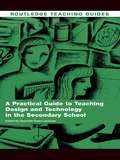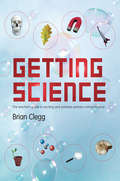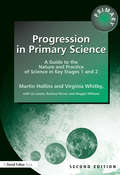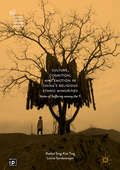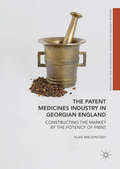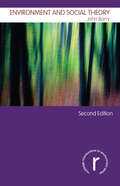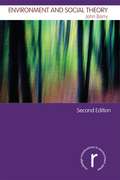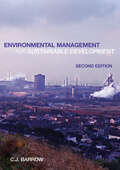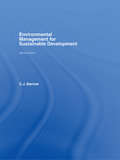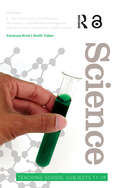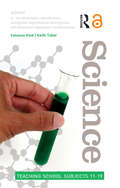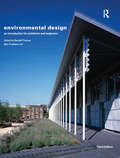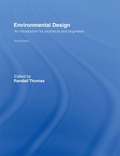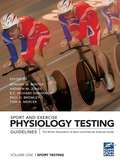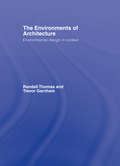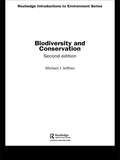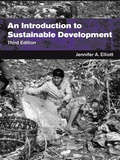- Table View
- List View
A Practical Guide to Teaching Design and Technology in the Secondary School
by Gwyneth Owen-JacksonContaining a wealth of practical activities and materials that provide excellent opportunities to analyse learning and performance within Design and Technology, this book also includes case studies and examples of existing good practice and a range of tried-and-tested strategies. Specially designed to be written in directly it provides a useful record of progress and is accompanied by a Companion Website. Designed to be used by student teachers, NQTs and beginning teachers, this workbook covers each main specialist area of Design Technology: electronics and communications technology (ECT), food technology, materials technology and textiles technology. Topics covered include: design and technology in the school curriculum the importance of health and safety the use of ICT in the teaching of design and technology planning lessons managing the classroom assessment issues the integration of literacy, numeracy, citizenship and sustainability into design and technology your own professional development. This book complements the market-leading textbook Learning to Teach Design and Technology in the Secondary School (also published by Routledge), but can also be used equally successfully on its own.
A Practical Guide to Teaching Design and Technology in the Secondary School
by Gwyneth Owen-JacksonContaining a wealth of practical activities and materials that provide excellent opportunities to analyse learning and performance within Design and Technology, this book also includes case studies and examples of existing good practice and a range of tried-and-tested strategies. Specially designed to be written in directly it provides a useful record of progress and is accompanied by a Companion Website. Designed to be used by student teachers, NQTs and beginning teachers, this workbook covers each main specialist area of Design Technology: electronics and communications technology (ECT), food technology, materials technology and textiles technology. Topics covered include: design and technology in the school curriculum the importance of health and safety the use of ICT in the teaching of design and technology planning lessons managing the classroom assessment issues the integration of literacy, numeracy, citizenship and sustainability into design and technology your own professional development. This book complements the market-leading textbook Learning to Teach Design and Technology in the Secondary School (also published by Routledge), but can also be used equally successfully on its own.
Getting Science: The Teacher's Guide to Exciting and Painless Primary School Science
by Brian CleggScience is rightly a fundamental part of primary school education, but that doesn’t make it easy to teach - especially for teachers without a science background. This straight talking book from an experienced science writer and communicator looks at how to make the most of it and give primary school children a good grounding in the topic. Getting Science sets out to engage the sense of wonder. The science in this book is not for the children, but for the adults who have to explain it. Starting with a whirlwind tour of the great milestones of modern science, Getting Science goes on to take each of the main curriculum topics and give it a new twist. It provides the information needed to understand the key topics better and be able to put them across with enthusiasm and energy. This book will help teachers to get children excited by science, to understand science rather than just answer questions. Getting Science makes science fun, approachable and comprehensible to those who just don’t get it.
Getting Science: The Teacher's Guide to Exciting and Painless Primary School Science
by Brian CleggScience is rightly a fundamental part of primary school education, but that doesn’t make it easy to teach - especially for teachers without a science background. This straight talking book from an experienced science writer and communicator looks at how to make the most of it and give primary school children a good grounding in the topic. Getting Science sets out to engage the sense of wonder. The science in this book is not for the children, but for the adults who have to explain it. Starting with a whirlwind tour of the great milestones of modern science, Getting Science goes on to take each of the main curriculum topics and give it a new twist. It provides the information needed to understand the key topics better and be able to put them across with enthusiasm and energy. This book will help teachers to get children excited by science, to understand science rather than just answer questions. Getting Science makes science fun, approachable and comprehensible to those who just don’t get it.
Progression in Primary Science: A Guide to the Nature and Practice of Science in Key Stages 1 and 2
by Martin Hollins Maggie Williams Virginia WhitbyUsing many examples drawn from classroom practice, this guide supports and aims to extend the student teacher's own subject knowledge and understanding of science in the context of the primary classroom. It offers an accessible guide to all the main concepts of Key Stages one and two science teaching. Illustrating the importance of issues such as resourcing and assessing science in the primary classroom, the book offers guidance for practicing teachers who consider themselves "non-specialists" in science.
Progression in Primary Science: A Guide to the Nature and Practice of Science in Key Stages 1 and 2
by Martin Hollins Maggie Williams Virginia WhitbyUsing many examples drawn from classroom practice, this guide supports and aims to extend the student teacher's own subject knowledge and understanding of science in the context of the primary classroom. It offers an accessible guide to all the main concepts of Key Stages one and two science teaching. Illustrating the importance of issues such as resourcing and assessing science in the primary classroom, the book offers guidance for practicing teachers who consider themselves "non-specialists" in science.
Culture, Cognition, and Emotion in China's Religious Ethnic Minorities: Voices of Suffering among the Yi
by Louise Sundararajan Rachel Sing-Kiat TingThis study examines the suffering narratives of two religious communities—Bimo and Christian—of the Yi minority who reside in the remote mountains of Sichuan and Yunnan, China, respectively. It is informed by the theoretical framework of ecological rationality, which posits that emotions influence, and are influenced, by cognitive styles that have co-evolved with the ecological niche of a culture. It was predicted and found that in times of adversity, traditional religious communities may differ in emotion expression, causal attribution, and help seeking behavior, with far-reaching ramifications in how they are uniquely vulnerable to the pitfalls of modernization. The authors hope that the voices of the study participants, heard through their harrowing narratives, may inspire a deepened sensitivity to the plight of rural Chinese communities as China races to become superpower in the global economy.
The Patent Medicines Industry in Georgian England: Constructing the Market by the Potency of Print
by Alan MackintoshIn this book, the ownership, distribution and sale of patent medicines across Georgian England are explored for the first time, transforming our understanding of healthcare provision and the use of the printed word in that era. Patent medicines constituted a national industry which was largely popular, reputable and stable, not the visible manifestation of dishonest quackery as described later by doctors and many historians. Much of the distribution, promotion and sale of patent medicines was centrally controlled with directed advertising, specialisation, fixed prices and national procedures, and for the first time we can see the detailed working of a national market for a class of Georgian consumer goods. Furthermore, contemporaries were aware that changes in the consumers’ ‘imagination’ increased the benefits of patent medicines above the effects of their pharmaceutical components. As the imagination was altered by the printed word, print can be considered as an essential ingredient of patent medicines. This book will challenge the assumptions of all those interested in the medical, business or print history of the period.
The Patent Medicines Industry in Georgian England: Constructing the Market by the Potency of Print
by Alan MackintoshIn this book, the ownership, distribution and sale of patent medicines across Georgian England are explored for the first time, transforming our understanding of healthcare provision and the use of the printed word in that era. Patent medicines constituted a national industry which was largely popular, reputable and stable, not the visible manifestation of dishonest quackery as described later by doctors and many historians. Much of the distribution, promotion and sale of patent medicines was centrally controlled with directed advertising, specialisation, fixed prices and national procedures, and for the first time we can see the detailed working of a national market for a class of Georgian consumer goods. Furthermore, contemporaries were aware that changes in the consumers’ ‘imagination’ increased the benefits of patent medicines above the effects of their pharmaceutical components. As the imagination was altered by the printed word, print can be considered as an essential ingredient of patent medicines. This book will challenge the assumptions of all those interested in the medical, business or print history of the period.
Environment and Social Theory
by John BarryWritten in an engaging and accessible manner by one of the leading scholars in his field, Environment and Social Theory, completed revised and updated with two new chapters, is an indispensable guide to the way in which the environment and social theory relate to one another. This popular text outlines the complex interlinking of the environment, nature and social theory from ancient and pre-modern thinking to contemporary social theorizing. John Barry: examines the ways major religions such as Judaeo-Christianity have and continue to conceptualize the environment analyzes the way the non-human environment features in Western thinking from Marx and Darwin, to Freud and Horkheimer explores the relationship between gender and the environment, postmodernism and risk society schools of thought, and the contemporary ideology of orthodox economic thinking in social theorising about the environment. How humans value, use and think about the environment, is an increasingly central and important aspect of recent social theory. It has become clear that the present generation is faced with a series of unique environmental dilemmas, largely unprecedented in human history. With summary points, illustrative examples, glossary and further reading sections this invaluable resource will benefit anyone with an interest in environmentalism, politics, sociology, geography, development studies and environmental and ecological economics.
Environment and Social Theory
by John BarryWritten in an engaging and accessible manner by one of the leading scholars in his field, Environment and Social Theory, completed revised and updated with two new chapters, is an indispensable guide to the way in which the environment and social theory relate to one another. This popular text outlines the complex interlinking of the environment, nature and social theory from ancient and pre-modern thinking to contemporary social theorizing. John Barry: examines the ways major religions such as Judaeo-Christianity have and continue to conceptualize the environment analyzes the way the non-human environment features in Western thinking from Marx and Darwin, to Freud and Horkheimer explores the relationship between gender and the environment, postmodernism and risk society schools of thought, and the contemporary ideology of orthodox economic thinking in social theorising about the environment. How humans value, use and think about the environment, is an increasingly central and important aspect of recent social theory. It has become clear that the present generation is faced with a series of unique environmental dilemmas, largely unprecedented in human history. With summary points, illustrative examples, glossary and further reading sections this invaluable resource will benefit anyone with an interest in environmentalism, politics, sociology, geography, development studies and environmental and ecological economics.
Environmental Management for Sustainable Development
by Chris BarrowEnvironmental management is a wide, expanding, and rapidly evolving field, affecting everyone from individual citizens to businesses; governments to international agencies. Indisputably, it plays a crucial role in the quest for sustainable development. This comprehensively updated second edition explores the nature and role of environmental management, covering key principles, practices, tools, strategies and policies, offers a thorough yet understandable introduction, and points to further in-depth coverage. Among the key themes covered are: sustainable development proactive approaches the precautionary principle the ‘polluter pays’ principle the need for humans to be less vulnerable and more adaptable. Reflecting the expansion and evolution of the field, this revised edition focuses strongly on sustainable development. There has been extensive restructuring to ensure the book is accessible to those unfamiliar with environmental management and it now includes greater coverage of topics including key resources under stress, environmental management tools, climate change and urban environmental management. With rapid expansion and development of the subject it is easy for those embarking on a course of study to become disorientated, but with its well-structured coverage, effective illustrations, and foundation for further, more-focused interest, this book is easily accessible to all.
Environmental Management for Sustainable Development
by Chris BarrowEnvironmental management is a wide, expanding, and rapidly evolving field, affecting everyone from individual citizens to businesses; governments to international agencies. Indisputably, it plays a crucial role in the quest for sustainable development. This comprehensively updated second edition explores the nature and role of environmental management, covering key principles, practices, tools, strategies and policies, offers a thorough yet understandable introduction, and points to further in-depth coverage. Among the key themes covered are: sustainable development proactive approaches the precautionary principle the ‘polluter pays’ principle the need for humans to be less vulnerable and more adaptable. Reflecting the expansion and evolution of the field, this revised edition focuses strongly on sustainable development. There has been extensive restructuring to ensure the book is accessible to those unfamiliar with environmental management and it now includes greater coverage of topics including key resources under stress, environmental management tools, climate change and urban environmental management. With rapid expansion and development of the subject it is easy for those embarking on a course of study to become disorientated, but with its well-structured coverage, effective illustrations, and foundation for further, more-focused interest, this book is easily accessible to all.
Science: Teaching School Subjects 11-19
by Vanessa Kind Keith TaberIn recognizing that new teachers often feel disempowered by the subject expertise they bring into teaching, this book not only covers the training standards for NQTs and the Induction Standards, but takes the reader beyond this by fully exploring issues relating to subject knowledge in learning to teach. Divided into three sections the book covers: framing the subject - defining subject knowledge and focusing on questions about science as a school subject teaching the subject - looking at pedagogical, curricular and pupil knowledge science within the professional community - focusing on the place of science within the wider curriculum and the teaching community. This refreshing new book provides stimulating assistance to subject specialists, from new teachers of science in the early years of professional development to those on a PGCE course or in their induction year. It is also suitable for subject leaders with mentor responsibilities and Advanced Skills Teachers undertaking specialist inset and teaching support.
Science: Teaching School Subjects 11-19
by Vanessa Kind Keith TaberIn recognizing that new teachers often feel disempowered by the subject expertise they bring into teaching, this book not only covers the training standards for NQTs and the Induction Standards, but takes the reader beyond this by fully exploring issues relating to subject knowledge in learning to teach. Divided into three sections the book covers: framing the subject - defining subject knowledge and focusing on questions about science as a school subject teaching the subject - looking at pedagogical, curricular and pupil knowledge science within the professional community - focusing on the place of science within the wider curriculum and the teaching community. This refreshing new book provides stimulating assistance to subject specialists, from new teachers of science in the early years of professional development to those on a PGCE course or in their induction year. It is also suitable for subject leaders with mentor responsibilities and Advanced Skills Teachers undertaking specialist inset and teaching support.
Environmental Design: An Introduction for Architects and Engineers
by Randall ThomasWritten and edited by a team of specialists at Max Fordham LLP, one of the UK’s leading environmental and building services engineering consultancies, Environmental Design is the result of their extensive experience in designing environmentally-friendly buildings. The principles of their approach, which they have taught in numerous schools of architecture and engineering, are clearly presented here. The book starts with some basic scientific principles and environmental issues and then moves on to site planning, energy use, materials and building form. Natural ventilation systems, high-efficiency mechanical equipment and alternative energy sources are also covered. State-of-the-art buildings of exceptional quality are incorporated throughout the text and illustrate the authors’ belief that environmentally responsible architecture can be visually exciting. They conclude with a selection of detailed case studies of award-winning projects – including, new for this third edition, Beaufort Court, King's Langley and the National Trust Headquarters, Swindon. This book is essential reading for architects, engineers, planners and students of these disciplines.
Environmental Design: An Introduction for Architects and Engineers
by Randall ThomasWritten and edited by a team of specialists at Max Fordham LLP, one of the UK’s leading environmental and building services engineering consultancies, Environmental Design is the result of their extensive experience in designing environmentally-friendly buildings. The principles of their approach, which they have taught in numerous schools of architecture and engineering, are clearly presented here. The book starts with some basic scientific principles and environmental issues and then moves on to site planning, energy use, materials and building form. Natural ventilation systems, high-efficiency mechanical equipment and alternative energy sources are also covered. State-of-the-art buildings of exceptional quality are incorporated throughout the text and illustrate the authors’ belief that environmentally responsible architecture can be visually exciting. They conclude with a selection of detailed case studies of award-winning projects – including, new for this third edition, Beaufort Court, King's Langley and the National Trust Headquarters, Swindon. This book is essential reading for architects, engineers, planners and students of these disciplines.
Sport and Exercise Physiology Testing Guidelines: The British Association of Sport and Exercise Sciences Guide
by Edward M. Winter Andrew M. Jones R.C. Richard Davison Paul D. Bromley Tom H. MercerSport and exercise physiologists are called upon to carry out physiological assessments that have proven validity and reliability, both in sport-specific and health-related contexts. A wide variety of test protocols have been developed and refined. This book is a comprehensive guide to these protocols and to the key issues relating to physiological testing. Volume I covers sport-specific testing, and Volume II covers clinical and exercise specific testing. With contributions from leading specialist sport, exercise and clincial physiologists, and covering a wide range of mainstream sports, special populations, and ethical, practical and methodological issues, these volumes represent an essential resource for sport-specific and clinical exercise testing in both research and applied settings. Visit the companion website at www.routledgesport.com/bases
Sport and Exercise Physiology Testing Guidelines: The British Association of Sport and Exercise Sciences Guide
by Edward M. Winter Andrew M. Jones R.C. Richard Davison Paul D. Bromley Tom H. MercerSport and exercise physiologists are called upon to carry out physiological assessments that have proven validity and reliability, both in sport-specific and health-related contexts. A wide variety of test protocols have been developed and refined. This book is a comprehensive guide to these protocols and to the key issues relating to physiological testing. Volume I covers sport-specific testing, and Volume II covers clinical and exercise specific testing. With contributions from leading specialist sport, exercise and clincial physiologists, and covering a wide range of mainstream sports, special populations, and ethical, practical and methodological issues, these volumes represent an essential resource for sport-specific and clinical exercise testing in both research and applied settings. Visit the companion website at www.routledgesport.com/bases
The Environments of Architecture: Environmental Design in Context
by Randall Thomas Trevor GarnhamThis well-illustrated 'think piece' provides a much needed and topical philosophical introduction to the place of environmental design in architecture. The Environments of Architecture sets out a range of considerations necessary to produce appropriate internal environments in the context of a wider discussion on the effect of building decisions on the broader environment. The authors, from architecture and engineering, academia and practice, provide a rounded and well-balanced introduction to this important topic. Starting from a belief that the built environment can contribute more positively to the planet and the pleasure of places as well as answering the practical demands of comfort, they cover site planning, form, materials, construction and operation as well as looking at design on a city level. Presenting a thoughtful and stimulating approach to the built environment, this book forms an excellent guide for practitioners, students and academics concerned with our built environment.
The Environments of Architecture: Environmental Design in Context
by Randall Thomas Trevor GarnhamThis well-illustrated 'think piece' provides a much needed and topical philosophical introduction to the place of environmental design in architecture. The Environments of Architecture sets out a range of considerations necessary to produce appropriate internal environments in the context of a wider discussion on the effect of building decisions on the broader environment. The authors, from architecture and engineering, academia and practice, provide a rounded and well-balanced introduction to this important topic. Starting from a belief that the built environment can contribute more positively to the planet and the pleasure of places as well as answering the practical demands of comfort, they cover site planning, form, materials, construction and operation as well as looking at design on a city level. Presenting a thoughtful and stimulating approach to the built environment, this book forms an excellent guide for practitioners, students and academics concerned with our built environment.
Biodiversity and Conservation
by Michael J. JeffriesThis revised second edition provides an introductory guide through the maze of interdisciplinary themes that comprise 'biodiversity.' It combines biological sciences with insights into the origins, variety and distribution of biodiversity, analysis of the social and political context, and the threats to, and opportunities for, the survival of natural systems. Whilst retaining its existing structure, this updated new edition reflects advances that have demonstrated the importance of living systems as drivers of environmental services vital to human health and security. The final chapter has been revised to tackle more explicitly the contrasting approaches to conservation, and throughout, the book has been updated to reflect new research and developments. With highly original international case studies and ample illustrations to explain difficult topics clearly, this excellent book remains the only introductory text which brings together the full range of theory and practice of ‘biodiversity’ and ‘conservation’.
Biodiversity and Conservation
by Michael J. JeffriesThis revised second edition provides an introductory guide through the maze of interdisciplinary themes that comprise 'biodiversity.' It combines biological sciences with insights into the origins, variety and distribution of biodiversity, analysis of the social and political context, and the threats to, and opportunities for, the survival of natural systems. Whilst retaining its existing structure, this updated new edition reflects advances that have demonstrated the importance of living systems as drivers of environmental services vital to human health and security. The final chapter has been revised to tackle more explicitly the contrasting approaches to conservation, and throughout, the book has been updated to reflect new research and developments. With highly original international case studies and ample illustrations to explain difficult topics clearly, this excellent book remains the only introductory text which brings together the full range of theory and practice of ‘biodiversity’ and ‘conservation’.
An Introduction to Sustainable Development
by Jennifer ElliottThis third edition of a successful, established text provides a concise and well-illustrated introduction to the ideas behind, and the practices flowing from the notion of sustainable development.
An Introduction to Sustainable Development
by Jennifer ElliottThis third edition of a successful, established text provides a concise and well-illustrated introduction to the ideas behind, and the practices flowing from the notion of sustainable development.
